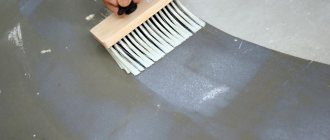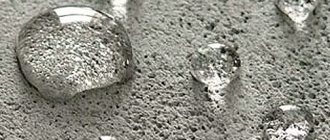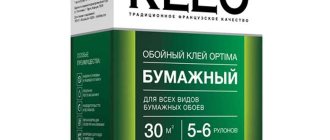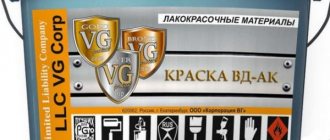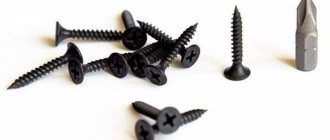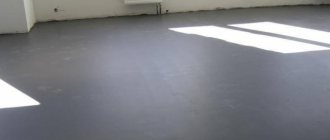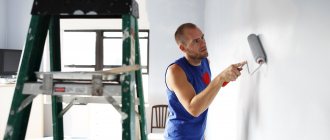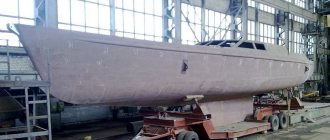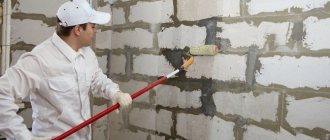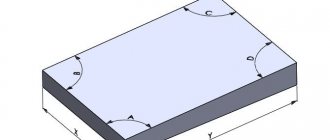Finishing interior and facade walls, ceilings, flooring - all this requires preliminary preparation of surfaces. In addition to carrying out repair work and leveling, it is necessary to strengthen the base material as much as possible, protect it from moisture penetration and the development of pathogenic microflora in its thickness, and create conditions for reliable adhesion to the finishing layer. All these functions are performed by a high-quality deep penetration primer.
Deep penetration primer consumption per 1 m²
Not so long ago, what methods did builders have to resort to to ensure normal adhesion of the finishing layers applied to the wall! The usual abundant moisture was used, solutions were prepared from PVA or CMC glues, and other “old-fashioned” methods were used. Today everything is simpler - just go to the store and buy a ready-made composition for the required base and type of finish. But to purchase, you need to know how much primer you will need.
So, deep penetration primer consumption per 1 m². The article will be structured as follows: first, a convenient calculator will be placed, which will allow you to quickly calculate the required amount of material, and then the necessary information will be provided for those who want to become more familiar with soil materials.
Calculator for calculating the amount of deep penetration primer
The calculator does not list all types of deep penetration primers - this is difficult to do due to the wide abundance of brands on sale. A selection was made of the most popular brands among finishers.
Go to calculations
It should be correctly understood that the calculator cannot give absolute accuracy, since a lot depends on the specific features of the base being processed. However, the reader will receive a general idea of the expected consumption with a sufficient degree of reliability.
Briefly about the main thing
The primer is necessary so that after applying it, glue, paint or other wet compounds can be used without effort on the base.
Primer consumption depends on the condition of the base. You can also calculate it if you apply the composition to a piece of wall approximately 1 by 1 m, and then calculate how much mixture was used.
Concrete contact mixture is considered the most durable among the others. Of these, Knauf is considered the highest quality, which lasts up to 80 years and holds the base well with other materials.
Ratings 0
Purpose of deep penetration primers
Primer is classified as an auxiliary building material, however, its importance is difficult to overestimate. It is this that largely ensures the success and high quality of general construction and especially finishing work.
In most cases, deep penetration primers are a suspension that is ready for use or requires dilution to the desired consistency with plain water. Less commonly found on sale are dry powder formulations, which must be prepared before use by mixing with water.
The suspension may be transparent or have a certain shade. High-quality primers have virtually no odor, which means it is easy to work with them even in completely enclosed spaces.
Most deep penetration primers are completely harmless, odorless, and can be used safely in enclosed spaces.
The composition of primers includes organic resins, adhesive mixtures, film-forming substances, and mineral components. Special additives introduced into the component composition improve the adhesive properties of the working solution and simplify working with it.
Whatever the component composition of the primer, it must meet certain requirements.
primer for walls
- Ensure maximum deep penetration into the material being processed, while simultaneously hardening it on the surface. Penetrating into pores and microcracks, the primer components fill them and then, after polymerization or crystallization, create a dense structure that successfully resists negative external influences, including moisture penetration.
- Create conditions for the best adhesion of the surface with mortars, adhesives, paints and varnishes.
- Possess antiseptic properties - reduce the risk of mold or mildew in primed building structures. A number of primers, in addition, tend to impart pronounced fire-fighting qualities to the treated materials.
- Have the shortest possible drying and polymerization (crystallization) times.
- Do not create a vapor-proof film - the treated surface should not lose the ability to “breathe”.
When choosing primers, you must be guided by a number of certain criteria:
- What material will be processed: concrete, gas silicate blocks, brick, plasterboard, cement or gypsum plaster, wood, etc.
- What kind of surface finishing is planned - will construction plaster or putty solutions, wallpaper glue, paints and varnishes be used?
- Where you plan to use the primer - outside the house or for interior work, for normal conditions or for rooms with high humidity, etc.
The main characteristics of the primer, as well as recommendations for its use, are usually indicated on the packaging label.
As a rule, manufacturers place the bulk of the necessary information on the standard packaging of the primer (buckets or canisters). The packaging label usually states:
- Basic composition of the suspension.
- Is the primer a ready-to-use composition or a concentrate that requires dilution?
- Recommendations for treating surfaces of different types and with different absorbent properties.
- Methods of applying the primer composition, conditions for working with the primer (permissible temperature range).
- Approximate primer consumption per 1 m² of treated surface (usually in milliliters for ready-made solutions, and in grams for concentrates).
- Drying time (polymerization) of the composition.
- Recommended storage conditions for the primer.
- Production date and warranty shelf life of the composition. Particular attention should be paid to this, since over time the primer may lose a number of its positive qualities.
What does consumption depend on?
There are many factors that influence the amount of soil mixture consumed per 1 m2 of surface:
- quality characteristics;
- material type;
- type of mixture;
- application methods;
- air humidity;
- temperature regime.
For each type of surface: metal, wood, brick, plaster, etc., a specific mixture composition is intended. They are manufactured in accordance with GOST requirements and differ in texture, color, density, viscosity and drying time. The determination of consumption per square meter takes into account all factors without exception. Professionals advise taking the coefficients and multiplying the standard rate by 1.15. Standard application rates are indicated on the label of the primer canister.
Important to remember! Each type of soil solution has its own specific role, and their many varieties make it possible to expand the scope of application. They differ in their composition, which can be supplemented with oils, resins, varnishes, etc. There are separate types for wood and metal. Special and universal soil mixtures are also widely represented.
Main types of deep penetration primers
Based on their basic component, primer compositions can be divided into several groups:
Acrylic primers
The most common variety among modern primers. It is an aqueous suspension of styrene-acrylate polymer binders and can be used for both internal and external work.
Acrylic primers are practically odorless, dry quickly, and penetrate perfectly into the material being treated. They are easily diluted to the desired consistency with water without losing their quality.
Treatment with acrylic primers sharply reduces the hygroscopicity of the surface, strengthens and removes dust from the material, and prevents the development of cracks. Unstable bases acquire additional mechanical strength and resistance to temperature changes.
The main advantage that sets acrylic primers apart from others is their versatility - they are suitable for almost any type of subsequent finishing.
In our calculator, acrylic primers are represented by the following brands:
- "Ceresit CT 17"
A kind of standard is the primer “Ceresit CT 17”.
This is one of the most popular brands of deep penetration primers, one might say - a kind of standard for other manufacturers.
Perfectly penetrates deep into the base, creating a protective film, sharply reducing the hygroscopicity of the material, eliminating the rapid drying of building mortars applied to the surface, even with the thinnest layers of application. Universal - suitable for almost any surface to be finished. The color pigment (the primer is light yellow in color) allows you to visually control the process of applying the composition - the treated surface will stand out.
Primer Ceresit CT 17
There are two primer options: for summer and for winter use - you should pay attention to this when purchasing.
The time for complete drying and polymerization under normal conditions is 4÷6 hours. Approximate consumption for a single application: from 100 to 200 ml/m² - this depends on the characteristics of the base.
Approximate price – about 550 rubles. for a 10 liter canister.
- "Knauf Tiefengrund"
One of the most economical primers is “Knauf Tiefengrund”.
Products of another well-deserved “authority” with a worldwide reputation. The primer is sold ready-to-use. It has a pronounced antibacterial effect - it disinfects the surface being treated well.
Knauf Tiefengrund
The composition is universal - suitable for application on any base, but is especially well adapted to any dry building mixtures and wall elements (gypsum plasterboard) from the same manufacturer. Pre-treatment with this primer allows you to perform all types of finishing work.
The disadvantages, which are very conditional, include only a high primer - for a 10-liter bucket they usually ask about 650-700 rubles. However, if you consider that the manufacturer declares material consumption to be only 100 ml/m², then the price no longer looks scary.
- "Bergauf TIEFGRUNT"
High-quality universal primer “Bergauf TIEFGRUNT”
Russian product. Primer of increased versatility, with excellent penetrating abilities. Designed for both “summer” and “winter” work, outside and inside buildings.
Has a good antiseptic effect. It dries very quickly - after an hour you can apply a second layer of primer or proceed to finishing work.
Consumption for initial application – from 100 to 200 ml/m².
Approximate cost: 450 rubles. for a 10 liter canister.
- Deep penetration primers “Prospectors”, “Unis”, “Optimist”
There is also a whole line of domestic products, which are practically in no way inferior to leading foreign analogues.
Acrylic primers of deep penetration, highly popular among Russian craftsmen
Only positive words can be said about any of these primers - they have earned their reputation for high quality and excellent performance. Currently, the products of the brands “Starateli”, “Optimist”, “Unis” compete on equal terms with the most popular Western models, and affordability makes domestic products more attractive.
— Primer “Prospectors: average consumption – up to 200 ml/m², estimated price – 500 rubles. for a 10 liter canister.
— Primer “Unis”: 150 ml/m² and 450 rub. - respectively.
— Primer “Optimist”: 120÷240 ml/m² and 500 rub. respectively.
Latex primers
These compositions are based on artificial latex, an analogue of the natural component obtained from the sap of the rubber tree. The main characteristic features of the created coating are its almost complete waterproofness, high elasticity, surface strength, and excellent resistance to compressive and tensile loads.
Typically, such primers are an opaque dispersed substance, more like paint. Penetrating and strengthening qualities are quite high, like those of acrylic compositions, but adhesive properties are inferior.
Such primers are good for quickly strengthening loose or crumbling substrates, and are usually used when preparing surfaces for finishing by painting - they create a reliable and evenly tinted primer layer. Latex compounds are well suited for processing wood and composite materials based on it. High resistance to moisture makes such primers very popular when carrying out repairs in rooms with high humidity.
In our calculator, latex primers are represented by one brand – “Optimum”, produced by Russian and “Leningradskie Krasny”.
Latex primer "Optimum" produced
This primer is suitable for all mineral surfaces of any degree of porosity. Color – at the buyer’s choice: from white to blue – depending on the shades of the planned finishing coating.
The hardening time of the primer under normal conditions is about 40 minutes, and application of the second layer or final painting is allowed after an hour and a half.
The average primer consumption is from 100 to 220 ml/m².
Approximate price – 440 rubles. for a 10 liter canister.
Silicone primers
Silicone primers are not widely used. The fact is that they, although they certainly have good penetrating and strengthening qualities, still form a layer on the surface that is not capable of high adhesion with all finishing materials. Most often, such deep penetration primers are used to prepare wall surfaces for the application of silicone-based finishing materials - decorative plasters and waterproof facade paints. With them, all the advantages of silicone impregnation are fully revealed.
In the calculator, silicone primers are represented by the composition “Odyssey Premium”
Silicone primer will only work well with finishing materials on the same basis.
This composition is capable of imparting pronounced hydrophobic qualities to any treated surface and providing antiseptic treatment of the material. The material is odorless and suitable for interior and exterior use. There is a high hiding power, absolute cleanliness from an environmental point of view, the material is not flammable and does not emit fumes hazardous to humans.
Hardening time is about 2 hours. After drying, a smooth matte surface is formed, ready for further finishing with silicone materials.
Approximate consumption is from 150 to 250 ml/m².
Approximate price – 850 rub. per canister 10 l.
Silicate primers
Not much will be said about this variety either, due to its limited use.
Such primers stand out against the general background by the fact that they are based not on organic compounds, but on mineral components - this is the well-known “liquid glass”, calcium silicate. Such impregnation penetrates very well into the surfaces being treated, filling pores and microcracks, and after crystallization, tightly clogging them. But the catch is that the walls (ceiling) treated in this way will be able to accept only silicate finishing in the future - paint or plaster. No other option is simply possible.
In the calculator, silicate impregnations are represented by the brand “KRAUTOL SILIKAT GRUND”.
Excellent strengthening and antiseptic qualities, but only for further finishing with silicate paints or plasters
This composition can also be used as a thinner for appropriate plasters and paints.
The approximate consumption of the composition for one-time priming is 150 ÷ 300 ml/m².
Approximate price: 350 rub. per canister 10 l.
Polyurethane primers
Also rarely used in everyday practice, but still worthy of attention.
The main purpose of such deep penetration compositions is to impart additional strength qualities to building structures, and most often polyurethane impregnations are used to strengthen concrete screeds or self-leveling floors. However, primers can create a durable protective coating even on metal, wood, ceramic tiles, asphalt and other materials.
For example, the calculator shows the one-component primer “PolyTek PU 0311”.
Polyurethane primer "PolyTek PU 0311" is excellent for hardening any floor surfaces
The organic solvent included in the primer, upon contact with air moisture, causes polymerization of the components, and under normal conditions, after 12 hours a high-strength, wear-resistant polyurethane coating will be created on the floor. It is recommended to apply the material in two layers.
When working, you should take precautions - in a liquid state, the primer has a pungent odor and can cause negative reactions in the body. After polymerization, the smell goes away, and the impregnation itself no longer poses any danger.
Approximate consumption is from 250 to 500 ml/m² for a single application. When applying the second layer, consumption is significantly reduced.
The material is quite expensive: about 300 rubles per kilogram.
And at the end of the publication - a little video information: the master shares the secrets of independently making a high-quality deep penetration primer
Betonokontakt Knauf
Also, the sweep consumption depends on the manufacturer. Different manufacturers have their own composition and proportions, which changes the amount of material consumed. For example, you can consider the consumption of Knauf Betokontakt primer per 1 m², its properties and consumption.
This mixture is used for foundations that do not absorb moisture or do so poorly. In this way, the material for plaster or putty is prepared. You can also consider the technical characteristics of the Knauf Betokontakt primer, which also includes the composition consumption:
- dries in less than a day;
- good concentration;
- applied by roller or mechanically;
- mixture consumption is 250-350 g per 1 m², taking into account that the material was not previously diluted.
The composition can be used for concrete, monolith, reinforced concrete, plasterboard or expanded polystyrene. It is also suitable for application to plaster or before gypsum-lime plaster is used.
Bucket of Knauf mixtureSource materik-m.ru
Betonokontakt Knauf
Also, the sweep consumption depends on the manufacturer. Different manufacturers have their own composition and proportions, which changes the amount of material consumed. For example, you can consider the consumption of Knauf Betokontakt primer per 1 m², its properties and consumption.
This mixture is used for foundations that do not absorb moisture or do so poorly. In this way, the material for plaster or putty is prepared. You can also consider the technical characteristics of the Knauf Betokontakt primer, which also includes the composition consumption:
- dries in less than a day;
- good concentration;
- applied by roller or mechanically;
- mixture consumption is 250-350 g per 1 m², taking into account that the material was not previously diluted.
The composition can be used for concrete, monolith, reinforced concrete, plasterboard or expanded polystyrene. It is also suitable for application to plaster or before gypsum-lime plaster is used.
Bucket of Knauf mixtureSource materik-m.ru
Features of concrete
Many novice repairmen believe that it is not necessary to protect concrete, but this is not true. Despite the fact that the material itself has a high strength index, it is still susceptible to aggressive environments and mechanical factors.
Water that gets into the pores of the material freezes and leads to delamination of the concrete base, resulting in cracks in the base. Also, the reinforcement contained inside the coating leads to destruction under the influence of various factors.
If the home has a concrete floor, then the owners should be aware that the top layer of such a base is very fragile and gradually begins to deteriorate and collapse during use.
Principles of preparing concrete for priming
The use of a primer for a concrete surface performs the following functions:
- the soil removes dust from the concrete, binding dust particles;
- protects against mold and corrosion;
- increases adhesion;
- improves the quality of finishing application;
- strengthens the base.
Before applying the primer, the concrete should be prepared. To do this, the surface is cleaned of dust and dirt, all oil stains are removed, and it is polished. If there are metal parts on the base, they need to be cleaned of corrosion.
Tips and recommendations for use
Working with such solutions is quite simple if you follow the following recommendations:
- The mixture must be applied with a brush or roller.
- It is necessary to ensure that the layer is distributed evenly.
- For rooms with a large area, it is better to treat the base with soil using a spray gun.
- It is not recommended to apply the solution in frosty conditions; the permissible temperature for use is 5-30 degrees.
- If the base is porous, then the primer must be applied in three layers.
- The next layer is applied only after the previous ball has completely dried.
